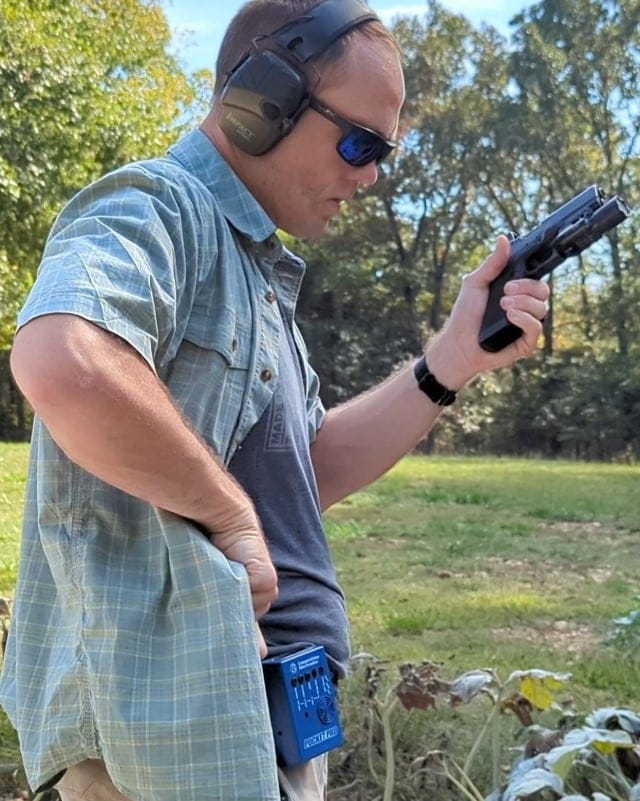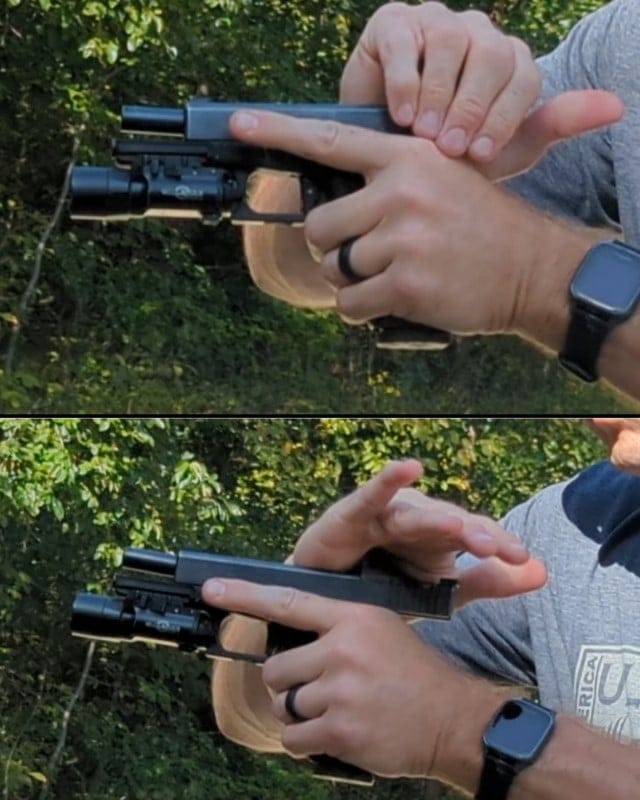Shooting requires mastery of fundamental skills. Shooters who can operate a firearm quickly and accurately have mastered the basic fundamentals of shooting: stance, grip, breathing, trigger control, sight picture, and sight alignment. In competitive or defensive shooting, the skillset expands into mastery of manipulating the firearm. This includes malfunction clearing and magazine changes. Beyond manipulating the firearm, there are more complex skills such as critical thinking under stress, threat perception, and tactical considerations (cover, movement, background, etc).
Some argue shooting is a science. I counter that it is more of an art form. Science is the systematic learning of our world through observation, experimentation, and testing of theories until evidence is obtained. While that is part of developing sound shooting skills, there is an art behind it. Art is the application of human creative skills. In shooting, creative skill and imagination produce many novel concepts and drills. Those drills are then tested (hopefully) scientifically to determine if the “art” is practical.
The mag change is an art form unto itself. Some, like Travis Tomasie, have perfected the mag change with such efficiency and speed that it’s awe-inspiring. Mag changes are critical as they keep your gun in the fight. Unlike movies, you’re bound to run out of ammunition. While the likelihood of a mag change during a gunfight is low, playing the odds is bound to invite Murphy’s Law. If it can go wrong, it will. Thus, mag changes are a skill worth developing on and off the range.
Magazine Position
Magazines can be positioned in a multitude of locations. The primary question when carrying a magazine is, “Can I access it for a reload?” For concealed carry, I carry mags on my non-dominant side on the hip or in a pocket. Pocket carry, while more discreet, presents some challenges as I’m unable to access the mag easily with my dominant hand. Practicing with these positions irons out deficiencies and identifies issues that may arise from that carry position.
There are some shooting rules that are non-negotiable. In my opinion, one of those is magazine orientation. I’ve seen many shooters carry their mags oriented with bullets facing behind them. This mag orientation is slow and I’ve seen many shooters fumble their way through reloads after emphatically stating it was “fast” for them. Over the years, I’ve seen only one shooter exhibit competency with this orientation out of the hundreds I’ve encountered.

Orienting the magazines with bullets facing forward (or towards the belt buckle) allows the shooter to properly index the mag when conducting a magazine change. The hand easily grasps the magazine and can withdraw with the index finger resting on the cartridge. This allows the shooter to easily feed the magazine into the mag well.
Firearm Position
Firearm position is critical to an efficient magazine change. Ideally, mag changes should be conducted behind cover or concealment in a defensive situation. However, it’s not ideal to lose sight of the target or threat you just engaged. The firearm should be brought towards the body and placed approximately shoulder height, just below the sight line of your target. The dominant arm moves towards the body with the elbow at an approximately 90-degree orientation. Point the mag well towards your non-dominant hip side. This places the firearm within your sight line without obstructing your view of the target.

The non-dominant hand draws the magazine and brings it to the magazine well. You now have a visual index of where to place the magazine. By placing the finger on top of the magazine, you also have a tactile reference point of where your magazine needs to be. The palm of the hand holding the magazine then firmly presses it into the firearm to seat it. Seat the magazine with sufficient force to ensure the magazine catch has engaged on the mag so it doesn’t inadvertently fall out.

“Charging” Methods
There are several basic methods of “charging” your semi-automatic firearm after a magazine change. To load a semi-automatic firearm, you must rack, or charge, the slide by pulling it to the rear and allowing it to load a live cartridge from the magazine. While it may seem obvious, this is a critical step in getting your gun back into the fight after a mag change.
There are three basic forms of charging the firearm during a mag change. The first method is to use the slide release. Unfortunately, some shooter’s hands are small and can’t reach the slide release. Left-handers aren’t as fortunate and can’t use their thumb to manipulate the slide release. I have larger hands and can reach the slide release with my trigger finger during a mag change. Over the years, I’ve practiced and became proficient at using my trigger finger to drop the slide and charge the firearm. However, this technique isn’t for everyone and it’s up to the shooter to find if, or what, works for them.

The last two methods offer some benefits over the slide release method. These methods involve gripping the slide or optic and using it to charge the weapon. This technique is arguably slower but fully compresses the recoil spring, offering less likelihood of the slide not seating completely and an out-of-battery malfunction occurring. After seating the magazine, the shooter obtains a complete grip on the slide with fingers (or palm and fingers) and pulls it towards their body. Once the slide is completely to the rear, the shooter lets go of the slide and allows the recoil spring to do the remaining work. Some novice shooters attempt to push the slide forward instead of letting go. This can cause a stoppage that prevents the slide from seating completely. Once the slide is to the rear, let go and let the gun do the work for you.
Optics are also handy for charging the gun. The non-dominant hand hooks onto the optic, which acts as a charging handle, and pulls the slide to the rear. The hand slides off the optic and allows the slide to close.
Types of Magazine Reloads
There are two basic types of reloads: an emergency or “slide lock” reload and a combat or tactical reload. Shooters experience an emergency reload when they’re unable to count rounds fired due to stress and the gun runs dry. The combat reload is a form of ammunition management where, during a lull in shooting or engaging the threat, the shooter conducts a magazine change to top off their firearm.

An empty firearm requires an emergency reload. The shooter immediately drops the empty mag while accessing the spare magazine. The shooter then reloads and charges the firearm as previously discussed.
The combat or tactical reload is a method of recharging the firearm during a tactically sound moment in a defensive encounter. For instance, if the shooter has fired several rounds and encountered a lull in the engagement, they can remove the partially expended magazine and replace it with a full magazine. This minimizes the risk of the shooter needing to conduct an emergency reload if there is an additional engagement with the threat(s). The pocket retains the partially expended magazine (preferably not the magazine carrier to reduce confusion over what magazines are full or not). Keep the partial magazine in the event the engagement continues.

I’ve found two schools of thought on the tactical reload. The first is to remove the partially expended magazine and retain it on your person then place a fresh mag into the firearm. I’m not partial to this method as the firearm has only one round in the chamber for a relatively long period of time. The shooter is more vulnerable if they have miscalculated the lull in the engagement.
The second method (and one I’m partial to) is to obtain your spare mag and bring it to the firearm. Eject the partial magazine into the hand holding the full magazine and conduct the mag change. Stow the partial magazine on your person. This method requires some practice to master but it is far more efficient than the first method. I’ve personally conducted this method under significant stress and found it efficient and reliable – if practiced beforehand.
Mastering the Art
Like dry fire, practicing magazine changes don’t cost you a penny and don’t require a trip to the range. Dummy cartridges are handy when practicing mag changes at home. Your time is the only expense. Earlier, I referred to magazine changes as an art form. While these basic techniques lay the foundation for efficient and competent magazine changes, there are non-standard methods a shooter may find work for their situation. By applying “art” to your situation, you can develop an efficient method for conducting mag changes.


